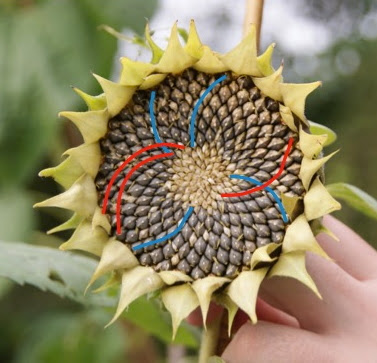Fibonacci numbers: 1,2,3,5,8,13,21,34,55,89,144,233,...
Lucas numbers: 1,3,4,7,11,18,29,47,76,123,...
In both cases each new number after the first two is the sum of its two predecessors. (Mathematically speaking, the first Fibonacci numbers are 0,1 and the first Lucas numbers 2,1 but these small terms are irrelevant here.)
Sunflower heads have a preference for displaying two sets of spirals, one consisting of a Fibonacci number of spirals, and the other (turning the opposite way) consisting of the next Fibonacci number of spirals. Though there are many exceptions (see here) the general rule is very striking.
The few examples below are taken from the archive Annotated seedhead images (here) that is part of
Jonathan Swinton and Erinma Ochu, Novel Fibonacci and non-Fibonacci structure in the sunflower: results of a citizen science experiment, 2016.The captions under our images are the numbers given to the sunflowers in the archive.
Every now and then, sunflower heads with 144 and 233 spirals are claimed (see here for the 1951 claim) but these world records are not ratified as long as no evidence is provided. We fear that these large specimens, rare as they are, may not be at the same time perfect enough to be unambiguously counted. Thus A.H. Church (On the Relation of Phyllotaxis to Mechanical Laws, 1904, p.26) writes
A record head grown at Oxford in 1899 measured 22 inches in diameter and, though it was not counted, there is very reason to believe that its parastichies belonged to the 144/233 series.Such beliefs being discounted, 89/144 is the evidenced record.
Among the Fibonacci-variants we have chosen an intoxicated sunflower that saw double and has twice the right number in both directions. To confirm the general rule our final specimen is a counterexample which has only spokes to show, and no spirals at all. Enjoy!
Fibonacci sunflowers
(21/34, 34/55, 55/89, 89/144)
(21/34, 34/55, 55/89, 89/144)
21 (red) turning clockwise + 34 (blue) turning counterclockwise:
 |
| #466 |
34 (blue) turning counterclockwise + 55 (red) turning clockwise:
 |
| #343 |
55 (red) turning counterclockwise + 89 (blue) turning clockwise:
 |
| #56 |
89 (red) turning counterclockwise + 144 (green) turning clockwise:
 |
| #104 |
A double-Fibonacci sunflower
(68/110)
(68/110)
2*34=68 (blue) turning counterclockwise + 2*55=110 (red) turning clockwise:
 |
| #136 |
A Lucas sunflower
(47/76)
(47/76)
47 (red) turning counterclockwise + 76 (blue) clockwise:
 |
| #92 |
A radial sunflower
 |
| #423 |

